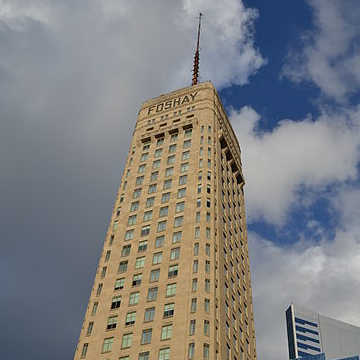Climb to the 31st floor of one of Minneapolis’s most famous buildings for spectacular views of the city. Once the tallest skyscraper in Minneapolis, the Foshay Tower is now hidden in the Minneapolis skyline but is easily distinguished because it displays Foshay’s name in 10-foot-high letters on the top of the building exterior. The tower is an historic landmark of the Twin Cities with an interesting tie to the stock market crash. Read more about the history below. The building is now a W Hotel with a restaurant and bar (Manny’s Steakhouse and the Prohibition Bar). Today visitors can visit the open air observation deck when weather cooperates for a beautiful view of Downtown Minneapolis. The following information has been reprinted courtesy of MNopeda and its authors Britt Aamodt under a Creative Commons License and may be reprinted under the same license. Since 1929, the Foshay Tower has been a vital part of the Minneapolis skyline. When it was built, the thirty-two-story tower was the tallest building between Chicago and the West Coast. In the 1970s and 1980s, much taller skyscrapers were built, but the attractive Foshay Tower remained a crowning glory of Minnesota architecture. Minneapolis businessman Wilbur B. Foshay was responsible for erecting this landmark. Foshay arrived in Minneapolis in 1915 to work for a local manufacturer of electric-light poles and telephone poles. He had spent most of the previous decade working for various utilities companies, and in 1916, he bought his own-the Ponca Electric Company of Nebraska. In 1917, he incorporated the W. B. Foshay Company in Minneapolis. Then he and his company went on a spending spree, buying utilities in thirty states, Alaska (which wouldn’t become a state until 1958), Canada, and Central America. Foshay’s company needed a headquarters. In the 1920s, the skyscraper was the dominant form of urban corporate architecture. Foshay wanted to build his own. He understood the promotional power of a tower with his name emblazoned on every side in ten-foot tall letters. Foshay told reporters that he had gotten the idea for the structure as a child. His father had taken him to see the Washington Monument in the nation’s capital. Foshay claimed that his memory of that marvelous sight inspired him to erect his tower. In 1928, the Foshay Building Corporation sold stock to raise the proposed $4,409,633.82 needed to erect the tower. Construction began that same year and continued through the summer of 1929. When the Foshay Tower was complete, it rose just over 447 feet in the heart of downtown Minneapolis. Leon Arnal of the Minneapolis architectural firm Magney and Tusler conceived its tapering Art Deco design. The tower actually was built upon an existing two-story structure, which formed the base of the new skyscraper. Foshay spared no expense. He hired famed sculptor Harriet Frishmuth to cast a bronze statue, Scherzo, for the building’s courtyard. An observation deck was added so visitors could get a bird’s-eye view of the downtown and Mississippi River. Marble, exotic woods, and bronze decorated the interiors. The twenty-seventh and twenty-eighth floors were occupied by Foshay’s lavish private offices and apartment, whose bathrooms boasted gold-plated faucets. Foshay celebrated the opening of the tower with a three-day event, August 30 to September 1, that featured fireworks, dancing girls, and religious services. John Philip Sousa wrote the “Foshay Tower Washington Memorial March,” which his band performed several times during the festivities. The U.S. Secretary of War, James W. Good, arrived from Washington, D.C., to dedicate the structure. The Foshay Company paid travel expenses for dozens of dignitaries from across the nation. Special guests were also given complimentary gold watches, courtesy of the company. The total cost added up to $126, 894. Days later, Foshay rushed to New York to secure money to keep his company afloat. Foshay’s empire collapsed soon after the celebration. The stock market crash in late October wiped him out professionally and personally. There was no money to pay off the tower’s builders, let alone to meet the payroll. Foshay’s check to Sousa bounced and the disgruntled bandleader forbade the playing of the “Foshay March” until the debt was paid. The W.B. Foshay Company folded, and the tower was put up for auction. Foshay faced criminal charges for mail fraud and, after two trials, ended up in Leavenworth Federal Penitentiary. Over the years, ownership of the Foshay Tower changed a number of times. But even when other downtown buildings of its era were torn down, the Foshay remained. It had become a cherished Minneapolis icon and a reminder of the golden age of the 1920s. In 1978, the structure was added to the National Register of Historic Places. Still, time and neglect took a toll on the aging building. Twin Cities real estate developer Ralph W. Burnet and Ryan Companies announced plans to renovate the tower in 2006. They hired local historic consultants Hess Roise and Company to help restore some of the original Art Deco features. On August 13, 2008, the refurbished Foshay Tower reopened as the W Minneapolis-The Foshay, a 230-room hotel. Ashford Hospitality Trust purchased the Foshay Tower for $86 million on November 10, 2015.Related Articles:
History of Foshay Tower
The Family Fun Twin Cities Directory is the most extensive collection of companies, organizations, activities and places to find things to do with kids in the Twin Cities.
Family Fun Twin Cities is not associated with the companies, municipalities or organizations and cannot book your birthday party, reserve sites or pass on complaints. Please use the contact information we provide.
Sharing of information is not an endorsement. We do, however, welcome constructive reviews from readers. Please feel free to leave comments providing helpful tips and information for other parents.

